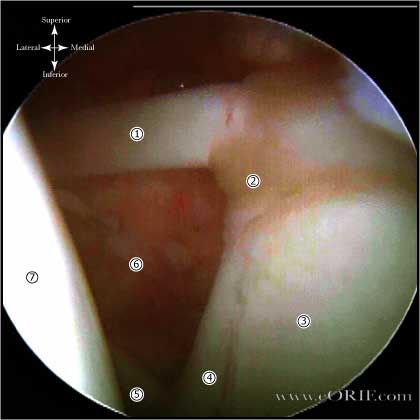|


|
synonyms: biceps tenosynovitis, biceps tendinosis, long head of biceps tendonitis
Biceps Tendonitis ICD-10
Biceps Tendonitis ICD-9
- 726.12(bicipital tenosynovitis)
Biceps Tendonitis Etiology / Epidemiology / Natural History
- may occur from inflammatory arthritis, osteoarthritis, osteochondromatosis, osteophyte in bicipital groove (usually medial wall), rotator cuff pathology, biceps instability
Biceps Tendonitis Anatomy
- Originates from the supraglenoid tubercle (30%), Glenoid labrum (45%), or supraglenoid tubercle and glenoid labrum (25%)
- Average length = 102mm
- Long head of the biceps tendon functions as a humeral head depressor and is a secondary restraint to anterior instability, particularily in the abducted/internally rotated position (Kumar VP CORR 1989:244:172).
- Stabilizing ligamentous pulley of the biceps consists of the confluence of the superior glenohumeral ligament and the coracohumeral ligament with fibrous contributions from the subscapularis and supraspinatus tendons. (Bennett WF, Arthroscopy 2001;17:173).
- The biceps tendon contains a large network of sensory and sympathetic nerve fibers, mainly at its insertion. (Alpantaki K, JBJS 2005;87A:1580).
- Intra-articular displacement of the biceps tendon indicates subscapularis rupture.
- Shoulder Anatomy
Biceps Tendonitis Clinical Evaluation
- Chronic anterior shoulder pain; radiates towards lateral part of the elbow and can reach dorsal part of the hand.
- Typically with overhead activity, often present at rest, may have night pain.
- Anterior shoulder pain on palpation of biceps tendon in bicipital groove which reproduces patient’s pain
- Yergusons: Elbow flexed 90 degrees with forearm pronated. Patient supinates the forearm and flex the elbow against resistance. Pain in the biciptal groove indicates long head of biceps tendon pathology.
- Speed's: Arm placed in 90 degrees of forward elevation with elbow extended and forearm supinated. Press the arm down against the patient's resistance. Pain in the anterior deltoid / bicipital groove indicates long head of biceps tendon pathology.
- Cross-body adduction test causes anterior shoulder pain instead of AC joint pain
- Impingement signs (Hawkins, Neer) may be postive
- Normal active/passive ROM
Biceps Tendonitis Xray / Diagnositc Tests
- A/P, and Lateral in the plane of the scapula, and axillary view; generally normal.
- MRI arthraphy with gadolimium may demonstrate increased signal or fraying within the long head of biceps tendon, SLAP lesion, as well as associated pathology ( RTC tear).
- Shoulder Arthroscopy: provides definitive evaluation of the long head of the biceps tendon. Tendon mst be pulled into joint during arthroscopy to view intratubercular portion. Tendon may be frayed, subluxed, thinned/atrophic or demonstrate marked synovitis or partial thickness tearing either in the intra-articular portion, or the intertubercular portion.
Biceps Tendonitis Classification / Treatment
- Nonoperative: NSAIDs, activity limitations, physiotherapy, corticosteriod injections
- Elderly, low demand patients: Biceps Tenotomy 23405, must discuss potential for cosmetic deformity (buldge in distal arm) before surgery. 21% deficit in suppination, 8% deficit in elbow flexion strength (Mariani E, CORR 1988;288:233).
- Young, athletically active patient: open/arthroscopic Biceps Tenodesis.
- Open/arthroscopic debridement and recentering techniques are generally not effective.
- Most biceps lesions are associated with other inciting pathology which must be corrected.
Biceps Tendonitis Associated Injuries / Differential Diagnosis
Biceps Tendonitis Complications
- Cosmetic deformity (buldge in distal arm) if rupture occurs.
- Pain
- Weakness
- Infection
- Shoulder stiffness
- CRPS
- Nerve or vascular injury
- Hematoma
- DVT/PE
- Risks of anesthesia including heart attack, stroke and death
Biceps Tendonitis Follow-up Care
- Biceps tenoditis patients are protected with a posterior splint or sling for 2 weeks with immediate passive elbow and shoulder ROM. Muscle strengthening is started at 6 weeks. Return to sporting activites at 3-6 months.
Biceps Tendonitis Review References
|


